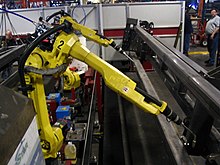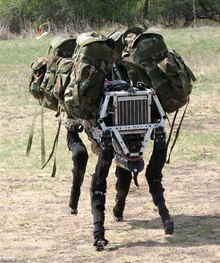Robots and the Future
Navigating the Robotic Frontier: Exploring Opportunities and Challenges
Introduction:
A robot is a machine—especially one programmable by a computer—capable of carrying out a complex series of actions automatically.[2] A robot can be guided by an external control device, or the control may be embedded within. Robots may be constructed to evoke human form, but most robots are task-performing machines, designed with an emphasis on stark functionality, rather than expressive aesthetics. ASIMO (2000) at the Expo 2005
ASIMO (2000) at the Expo 2005 Articulated welding robots used in a factory are a type of industrial robot.
Articulated welding robots used in a factory are a type of industrial robot.
The dawn of the robotic age heralds a transformative era, promising to reshape industries, redefine human interaction, and propel us into uncharted territory. As we stand on the cusp of this technological revolution, it is crucial to examine the opportunities and challenges that lie ahead.
I. Revolutionizing Industries:
A. Automated Manufacturing: -
Streamlining processes for increased efficiency. - Reducing costs and improving precision with robotic systems.
B. Collaborative Robotics: - Integration of cobots in tasks requiring flexibility and dexterity. - Enhancing productivity and fostering safer work environments.
II. Redefining Mobility:
A. Autonomous Vehicles: - Revolutionizing transportation with self-driving cars. - Challenging conventional notions of mobility and urban planning.
B. Delivery Drones: - Transforming logistics with unmanned aerial vehicles. - Expanding accessibility to remote areas and speeding up delivery times.
III. Innovating Healthcare:
A. Surgical Robotics: - Enabling minimally invasive procedures for improved patient outcomes. - Enhancing precision and reducing recovery times in surgery.
B. Assistive Robots: - Supporting individuals with disabilities to enhance independence. - Improving quality of life through personalized assistance and companionship.
IV. Exploring New Frontiers:
A. Space Exploration: - Deploying rovers and robotic probes to explore distant planets. - Expanding our understanding of the universe and potential for colonization.
B. Underwater Robotics: - Unraveling the mysteries of the deep sea with underwater drones. - Studying marine life and ecosystems in inaccessible environments.
V. Addressing Complexities and Challenges:
A. Job Displacement: - Addressing concerns about automation and its impact on employment. - Reskilling and adapting to the changing nature of work in a robotic world.
B. Ethical Considerations: - Debating autonomy and decision-making in robotic systems. - Establishing guidelines and regulations to ensure ethical use of technology.
C. Societal Implications: - Mitigating risks of misuse and unintended consequences of advanced robotics. - Fostering dialogue and collaboration to navigate the societal impacts of automation.
Conclusion:
As we embark on this journey into the robotic frontier, it is essential to approach the opportunities and challenges with foresight, innovation, and ethical consideration. By harnessing the transformative power of robotics while addressing concerns and complexities, we have the opportunity to shape a future where humanity and technology coexist harmoniously, enriching our lives and propelling us toward new horizons of possibility.
References
- ^ "Four-legged Robot, 'Cheetah,' Sets New Speed Record". Reuters. 6 March 2012. Archived from the original on 22 October 2013. Retrieved 5 October 2013.
- ^ Definition of 'robot'. Oxford English Dictionary. Retrieved 27 November 2016.
- ^ "Forecasts – Driverless car market watch". driverless-future.com. Retrieved 26 September 2023.
- ^ Jump up to:
- a b "robotics". Oxford Dictionaries. Archived from the original on 18 May 2011. Retrieved 4 February 2011.
- ^ Margolius, Ivan (Autumn 2017). "The Robot of Prague" (PDF). The Friends of Czech Heritage (17): 3–6. Archived (PDF) from the original on 11 September 2017.
- ^ Jump up to:
- a b c Zunt, Dominik. "Who did actually invent the word "robot" and what does it mean?". The Karel Čapek website. Archived from the original on 4 February 2012. Retrieved 11 September 2007.































